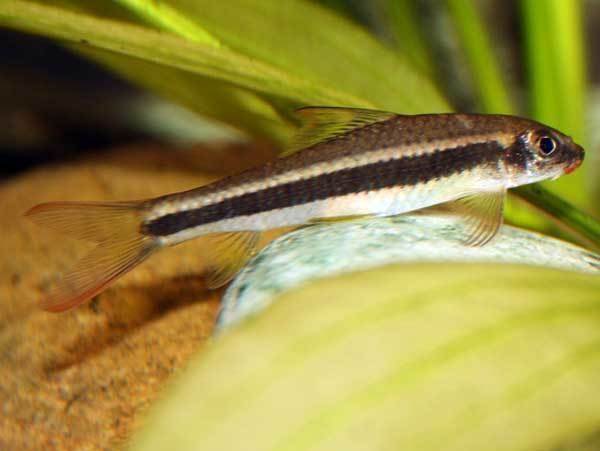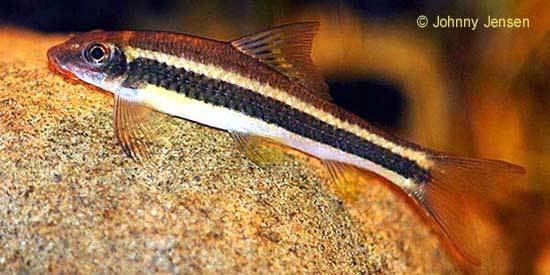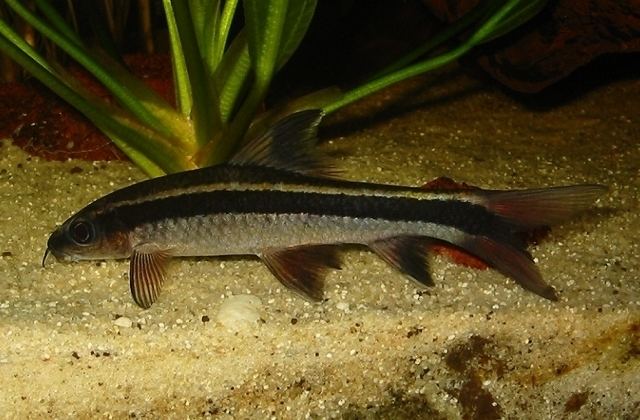Rank Species | Phylum Chordata Higher classification Epalzeorhynchos | |
 | ||
Scientific name Epalzeorhynchos kalopterus Similar Epalzeorhynchos, Siamese algae eater, Crossocheilus, Gyrinocheilus aymonieri, Cyprinidae | ||
The flying fox (Epalzeorhynchos kalopterus) is a Southeast Asian species of freshwater fish in the Cyprinidae family. It is commonly seen in the aquarium trade. Among others, it is known to eat green algae. It is sometimes mistakenly referred to as the Siamese algae eater.
Contents
- Description
- Distribution and habitat
- Tank requirements
- Behavior
- Life span
- Diet
- Breeding
- Similar species
- References

Description
The flying fox fish has a characteristic long body with a flat abdominal area. Its dorsal area has a coloration ranging from olive to dark brown. The lower half of its body has a yellowish white hue. A brownish-black line is apparent from its mouth, eye and the caudal fins. On top of this brownish-black line is a gold-colored stripe. The eyes of a flying fox may have a reddish iris. Its dorsal, anal and ventral finnage consisting of a black band and a white edge.
Although known to grow up to 6 inches (15.24 cm), flying foxes have an average length of 4.7 inches (11.94 cm) in an aquarium setting.
Distribution and habitat

The flying fox is a bottom-dweller that thrives in fast-flowing foothill rivers and streams of the Thai-Malay Peninsula, Borneo, Java and Sumatra in Southeast Asia.
Tank requirements

A 20 to 40 gallon tank or bigger lined with fine gravel substrate is suitable for an average-sized flying fox fish. Being bottom-dwellers, the aquarium for flying foxes usually has broad-leaved plants, rocks, and driftwood to serve as hiding places. Because the flying fox is a known algae-eater, the tank is normally provided with adequate lighting. Flying foxes can survive in aquarium water that has a 6 to 7.5 pH reading, a water hardness ranging from 2 to 12 dH, and temperatures maintained at 23 to 27 °C (73 to 81 °F).
Behavior

Being a community-tank fish, flying foxes are compatible with acaras, angelfish, barbs, danios, eartheaters, gouramis, knifefish, loaches, tetras and rasboras. Sometimes the Flying Fox will be a little aggressive towards other smaller aquarium fish if it is hungry, resulting in eating them. Aquarium fishkeepers may also keep flying fox fish as a lone tank fish or in schools. A small congregation of flying fox fish may, however, exhibit territorial behavior. Lone foxes often challenge other species for dominance, particularly paradise fish males, which they will chase and be chased by, as well as swim in a tight circle with, though usually neither is injured, and usually the paradise fish wins.
Life span
In the aquarium, flying foxes may live from 8 to 10 years.
Diet
Although an algae eater, flying foxes are also known to consume food in the form of flakes, wafers and tablets. Being omnivorous, vegetables such as spinach, zucchini and lettuce, as well as live planarians, tubifex worms, crustaceans and other aquatic insects are normally offered to flying foxes. Oatmeal is also served to flying foxes. It does not consume red algae.
Breeding
Gender among flying foxes is difficult to determine. Flying foxes are not known to reproduce in the aquarium.
Similar species
The flying fox is similar to the Siamese algae eater (Crossocheilus oblongus) and the false flying fox (Garra cambodgiensis) when young.
